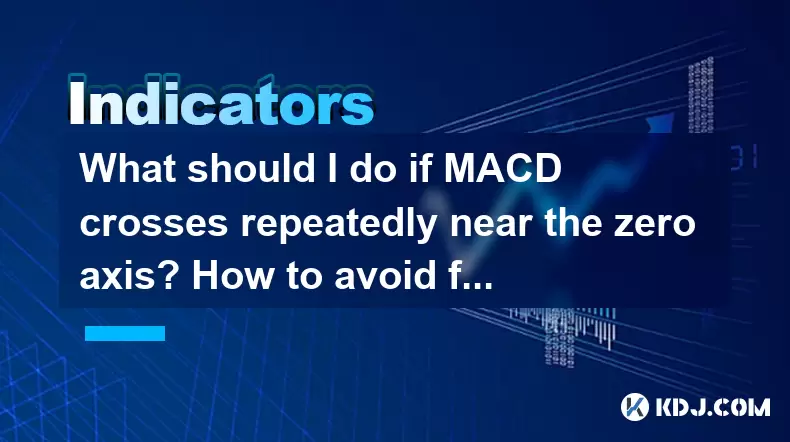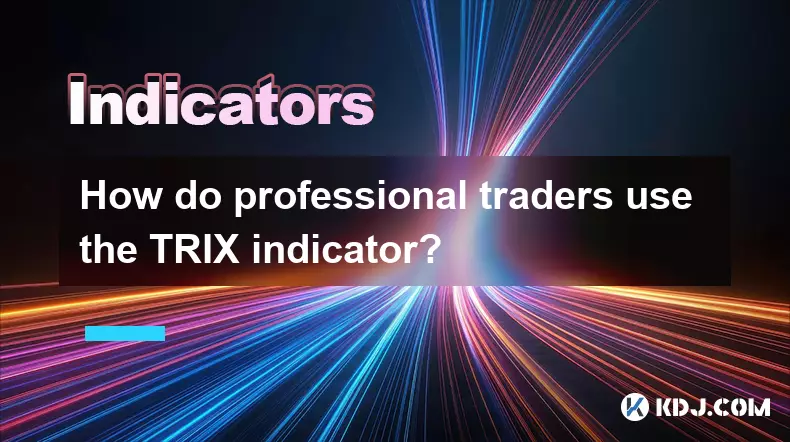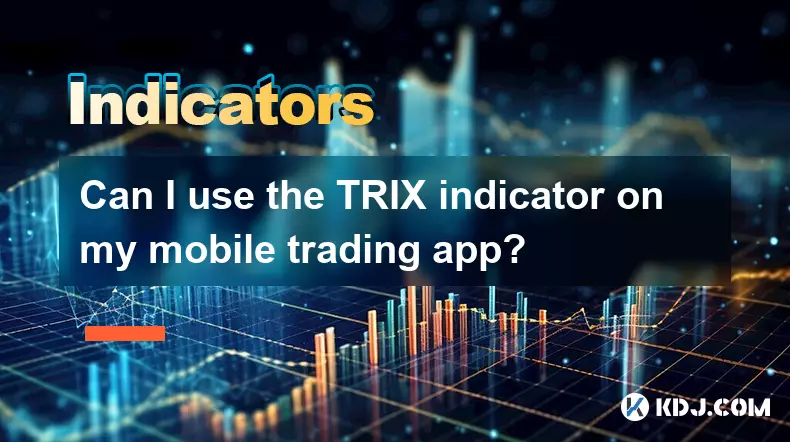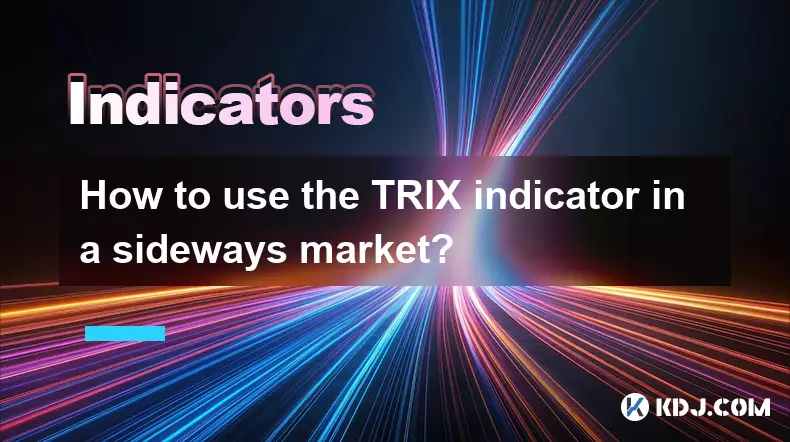-
 bitcoin
bitcoin $95203.028270 USD
-4.12% -
 ethereum
ethereum $3151.730711 USD
-1.61% -
 tether
tether $0.999170 USD
-0.04% -
 xrp
xrp $2.273039 USD
-1.55% -
 bnb
bnb $924.288432 USD
0.14% -
 solana
solana $141.112899 USD
-2.02% -
 usd-coin
usd-coin $0.999964 USD
0.02% -
 tron
tron $0.293976 USD
0.82% -
 dogecoin
dogecoin $0.160772 USD
-1.84% -
 cardano
cardano $0.506357 USD
-3.90% -
 hyperliquid
hyperliquid $37.900515 USD
0.03% -
 zcash
zcash $644.358451 USD
26.66% -
 chainlink
chainlink $14.062007 USD
-2.60% -
 bitcoin-cash
bitcoin-cash $484.381072 USD
-5.12% -
 unus-sed-leo
unus-sed-leo $9.199874 USD
0.27%
What should I do if MACD crosses repeatedly near the zero axis? How to avoid false signals in volatile markets?
In volatile crypto markets, frequent MACD crosses near the zero axis can lead to false signals; use RSI, volume, and longer timeframes to confirm trends before trading.
May 23, 2025 at 01:35 pm

Introduction to MACD and Its Use in Cryptocurrency Trading
The Moving Average Convergence Divergence (MACD) is a popular technical indicator used by traders in the cryptocurrency market to identify potential buy and sell signals. It consists of two lines—the MACD line and the signal line—and a histogram that measures the distance between these two lines. When the MACD line crosses the signal line, it can generate buy or sell signals. However, a common issue traders face is the repeated crossing of the MACD near the zero axis, which often leads to false signals, especially in volatile markets.
Understanding Repeated MACD Crosses Near the Zero Axis
When the MACD line crosses the signal line near the zero axis, it can be a sign of market indecision. This phenomenon occurs frequently in volatile markets where prices fluctuate rapidly. Such crosses can generate multiple buy and sell signals in a short period, leading to confusion and potential losses if acted upon without proper analysis.
Identifying False Signals in Volatile Markets
Volatility in the cryptocurrency market can lead to false signals, which are indications that suggest a trend that does not materialize. These false signals are particularly common when the MACD repeatedly crosses near the zero axis. To avoid falling into the trap of these false signals, traders need to employ additional tools and strategies to confirm the validity of the signals generated by the MACD.
Strategies to Confirm MACD Signals
To enhance the reliability of MACD signals, especially when they occur near the zero axis, traders can use the following strategies:
Using Additional Indicators: Combining the MACD with other technical indicators such as the Relative Strength Index (RSI), Bollinger Bands, or the Stochastic Oscillator can help confirm the signals. For instance, if the MACD indicates a buy signal but the RSI is in overbought territory, it might be wise to wait for further confirmation.
Analyzing Volume: Volume is a crucial factor in confirming trends. A MACD signal accompanied by high trading volume is more likely to be valid. If the volume does not support the MACD signal, it could be a false signal.
Waiting for a Clear Trend: Instead of acting immediately on a MACD cross near the zero axis, traders can wait for the MACD line to move away from the zero axis and establish a clear trend. This approach reduces the likelihood of acting on false signals.
Using Longer Timeframes: Analyzing the MACD on longer timeframes can help filter out short-term noise and provide more reliable signals. For example, a daily chart might offer clearer signals than a 15-minute chart.
Practical Steps to Implement These Strategies
To effectively implement the above strategies, traders can follow these detailed steps:
Combining MACD with RSI:
- Open your trading platform and select the cryptocurrency pair you want to analyze.
- Add the MACD indicator to your chart. Ensure it is set to the standard parameters (12, 26, 9).
- Add the RSI indicator to the same chart. Set it to the standard 14 periods.
- Monitor the MACD for crosses near the zero axis. When a cross occurs, check the RSI.
- If the RSI is above 70 (overbought) or below 30 (oversold), consider waiting for the RSI to move back to a neutral range before acting on the MACD signal.
Analyzing Volume:
- Add a volume indicator to your chart.
- When a MACD cross occurs near the zero axis, observe the volume bars.
- If the volume increases significantly following the cross, it supports the validity of the MACD signal. If the volume remains low or decreases, it might be a false signal.
Waiting for a Clear Trend:
- When the MACD crosses near the zero axis, refrain from immediate action.
- Wait for the MACD line to move a significant distance away from the zero axis, indicating a stronger trend.
- Once the MACD line has moved away from the zero axis, reassess the chart and consider entering a trade if other indicators align.
Using Longer Timeframes:
- Open multiple charts for the same cryptocurrency pair, each set to different timeframes (e.g., 15-minute, 1-hour, 4-hour, and daily).
- Analyze the MACD on each chart.
- If the MACD shows consistent signals across multiple timeframes, especially on the longer ones, it increases the likelihood of a valid signal.
- Focus on the signals from the longer timeframes for your trading decisions.
Case Study: Applying These Strategies in Real Market Conditions
Consider a scenario where Bitcoin (BTC) is experiencing high volatility, and the MACD on a 15-minute chart repeatedly crosses near the zero axis. Here’s how a trader could apply the strategies mentioned:
Combining MACD with RSI: The trader observes a MACD cross near the zero axis indicating a potential buy signal. However, the RSI is at 75, suggesting overbought conditions. The trader decides to wait until the RSI drops below 70 before considering a buy.
Analyzing Volume: Following the MACD cross, the trader checks the volume. The volume bars show a slight increase but not a significant surge. The trader concludes that the signal might be false and waits for further confirmation.
Waiting for a Clear Trend: The MACD line moves away from the zero axis, indicating a more robust trend. The trader now sees the MACD line well above the signal line and the zero axis, suggesting a stronger buy signal. The trader then enters a long position.
Using Longer Timeframes: The trader checks the MACD on a 4-hour chart and sees that it also indicates a buy signal. This consistency across timeframes strengthens the trader’s confidence in the signal, and they proceed with the trade.
Frequently Asked Questions
Q: Can I use the MACD alone for trading decisions?A: While the MACD can be a powerful tool, using it alone, especially in volatile markets, can lead to false signals. It is advisable to combine it with other indicators and strategies to confirm signals.
Q: How often should I check the MACD for crosses near the zero axis?A: The frequency of checking the MACD depends on your trading timeframe. For short-term trading, you might check it several times a day, while for longer-term trading, checking it once a day or less might be sufficient.
Q: Is it better to use the MACD on shorter or longer timeframes to avoid false signals?A: Longer timeframes generally provide more reliable signals as they filter out short-term market noise. However, the choice of timeframe should align with your trading strategy and goals.
Q: Can volume alone confirm a MACD signal?A: Volume can provide valuable confirmation, but it should not be used alone. Combining volume analysis with other indicators and strategies offers a more robust approach to confirming MACD signals.
Disclaimer:info@kdj.com
The information provided is not trading advice. kdj.com does not assume any responsibility for any investments made based on the information provided in this article. Cryptocurrencies are highly volatile and it is highly recommended that you invest with caution after thorough research!
If you believe that the content used on this website infringes your copyright, please contact us immediately (info@kdj.com) and we will delete it promptly.
- Decoding the Crypto Crystal Ball: Will Apeing Outpace XRP and BNB in 2025?
- 2025-11-15 12:25:02
- HBAR, Zero Knowledge, and the Privacy Revolution: What's the Smart Money Doing?
- 2025-11-15 11:40:02
- Crypto Presales Face-Off: Is Digitap ($TAP) Really Toppling BlockDAG?
- 2025-11-15 11:35:01
- Tokenization, 24/7 Markets, and Vlad Tenev: The Future of Finance?
- 2025-11-15 11:30:01
- Bull Market Bonanza: Crypto Presales and Explosive Growth Opportunities
- 2025-11-15 11:25:01
- Crypto Carnage: Navigating Selling and Liquidations in a Wild Market
- 2025-11-14 16:50:01
Related knowledge

What's the best way to learn the TRIX indicator?
Nov 10,2025 at 12:39pm
Understanding the Basics of the TRIX Indicator1. The TRIX (Triple Exponential Average) indicator is a momentum oscillator designed to filter out short...

How to identify trend exhaustion with the TRIX indicator?
Nov 15,2025 at 04:20pm
Decentralized Exchanges Gain Momentum in 20241. Decentralized exchanges (DEXs) have seen a significant rise in trading volume, surpassing several cent...

How do professional traders use the TRIX indicator?
Nov 06,2025 at 04:40pm
Understanding the TRIX Indicator in Crypto TradingThe TRIX (Triple Exponential Average) indicator is a momentum oscillator used by professional trader...

Can I use the TRIX indicator on my mobile trading app?
Nov 07,2025 at 07:40pm
The TRIX indicator, a momentum oscillator designed to filter out short-term fluctuations and highlight long-term trends, has become increasingly popul...

How to use the TRIX indicator in a sideways market?
Nov 10,2025 at 03:00pm
Bitcoin’s Role in Decentralized Finance Evolution1. Bitcoin remains the cornerstone of decentralized finance, serving as both a store of value and a b...

How does volume affect the signals from the TRIX indicator?
Nov 13,2025 at 07:39am
Understanding the TRIX Indicator in Cryptocurrency TradingThe TRIX (Triple Exponential Average) indicator is a momentum oscillator designed to filter ...

What's the best way to learn the TRIX indicator?
Nov 10,2025 at 12:39pm
Understanding the Basics of the TRIX Indicator1. The TRIX (Triple Exponential Average) indicator is a momentum oscillator designed to filter out short...

How to identify trend exhaustion with the TRIX indicator?
Nov 15,2025 at 04:20pm
Decentralized Exchanges Gain Momentum in 20241. Decentralized exchanges (DEXs) have seen a significant rise in trading volume, surpassing several cent...

How do professional traders use the TRIX indicator?
Nov 06,2025 at 04:40pm
Understanding the TRIX Indicator in Crypto TradingThe TRIX (Triple Exponential Average) indicator is a momentum oscillator used by professional trader...

Can I use the TRIX indicator on my mobile trading app?
Nov 07,2025 at 07:40pm
The TRIX indicator, a momentum oscillator designed to filter out short-term fluctuations and highlight long-term trends, has become increasingly popul...

How to use the TRIX indicator in a sideways market?
Nov 10,2025 at 03:00pm
Bitcoin’s Role in Decentralized Finance Evolution1. Bitcoin remains the cornerstone of decentralized finance, serving as both a store of value and a b...

How does volume affect the signals from the TRIX indicator?
Nov 13,2025 at 07:39am
Understanding the TRIX Indicator in Cryptocurrency TradingThe TRIX (Triple Exponential Average) indicator is a momentum oscillator designed to filter ...
See all articles









































































